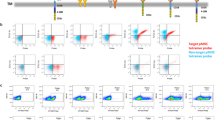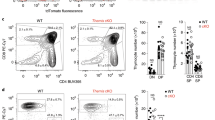Abstract
Recombinant immunoreceptors are modularily composed of extracellular antigen binding and intracellular signalling domains that are preferentially derived from CD3ζ or FcɛRIγ. The impact of the signalling domain on the stability of immuoreceptor expression and function is not completely understood. To address this issue, we generated and expressed a panel of recombinant ζ- and γ-chain immunoreceptors, respectively, in human peripheral blood T cells. The expression level of ζ-chain immunoreceptors in human T cells is significantly lower than those of the homologous γ-chain receptors. Low ζ-chain receptor expression in peripheral T cells is because of the intracellular signalling domain and independent of the FcɛRIγ or CD3ζ transmembrane region. Expression of both receptors decreases upon prolonged cultivation. Shortly after receptor engraftment, target cell lysis and induction of IFN-γ secretion are mediated with similar efficiency by ζ- and γ-chain immunoreceptors. Upon prolonged propagation, however, T-cell activation mediated by ζ-chain immunoreceptors is more efficient than by γ-chain receptors, indicating that the initial high expression level of γ-chain immunoreceptors compensates its lower activation capacity. Consequently, γ-chain immunoreceptors exhibit a higher threshold value for specific activation and are more pronouncedly inhibited by soluble ligand antigen compared to the homologous ζ-chain receptor. These findings have substantial consequences for the design of recombinant immunoreceptors for use in adoptive immunotherapy.
This is a preview of subscription content, access via your institution
Access options
Subscribe to this journal
Receive 12 print issues and online access
$259.00 per year
only $21.58 per issue
Buy this article
- Purchase on Springer Link
- Instant access to full article PDF
Prices may be subject to local taxes which are calculated during checkout








Similar content being viewed by others
References
Abken H, Hombach A, Reinhold U, Ferrone S . Can combined T- cell- and antibody-based immunotherapy outsmart tumor cells? Immunol Today 1998; 19: 2–5.
Eshhar Z, Waks T, Gross G, Schindler DG . Specific activation and targeting of cytotoxic lymphocytes through chimeric single chains consisting of antibody-binding domains and the gamma or zeta subunits of the immunoglobulin and T-cell receptors. Proc Natl Acad Sci USA 1993; 90: 720–724.
Hombach A et al. CD4+ T cells engrafted with a recombinant immunoreceptor efficiently lyse target cells in a MHC antigen- and Fas-independent fashion. J Immunol 2001; 167: 1090–1096.
Trinchieri G, Valiante N . Receptors for the Fc fragment of IgG on natural killer cells. Nat Immun 1993; 12: 218–234.
Malissen B, Schmitt-Verhulst AM . Transmembrane signalling through the T-cell-receptor–CD3 complex. Curr Opin Immunol 1993; 5: 324–333.
Paolini R et al. Different roles for the Fc epsilon RI gamma chain as a function of the receptor context. J Exp Med 1995; 181: 247–255.
Frank SJ, Engel I, Rutledge TM, Letourneur F . Structure/function analysis of the invariant subunits of the T cell antigen receptor. Semin Immunol 1991; 3: 299–311.
Howard FD, Rodewald HR, Kinet JP, Reinherz EL . CD3 zeta subunit can substitute for the gamma subunit of Fc epsilon receptor type I in assembly and functional expression of the high-affinity IgE receptor: evidence for interreceptor complementation. Proc Natl Acad Sci USA 1990; 87: 7015–7019.
Liu CP et al. Development and function of T cells in T cell antigen receptor/CD3 zeta knockout mice reconstituted with Fc epsilon RI gamma. Proc Natl Acad Sci USA 1997; 94: 616–621.
Patel SD et al. Impact of chimeric immune receptor extracellular protein domains on T cell function. Gene Therapy 1999; 6: 412–419.
Hombach A et al. T cell activation by recombinant Fc epsilon RI gamma-chain immune receptors: an extracellular spacer domain impairs antigen-dependent T cell activation but not antigen recognition. Gene Therapy 2000; 7: 1067–1075.
Moritz D, Groner B . A spacer region between the single chain antibody- and the CD3 zeta-chain domain of chimeric T cell receptor components is required for efficient ligand binding and signaling activity. Gene Therapy 1995; 2: 539–546.
Willemsen RA et al. Grafting primary human T lymphocytes with cancer-specific chimeric single chain and two chain TCR. Gene Therapy 2000; 7:1369–1377.
Weijtens ME, Hart EH, Bolhuis RL . Functional balance between T cell chimeric receptor density and tumor associated antigen density: CTL mediated cytolysis and lymphokine production. Gene Therapy 2000; 7: 35–42.
Kuster H, Thompson H, Kinet JP . Characterization and expression of the gene for the human Fc receptor gamma subunit. Definition of a new gene family. J Biol Chem 1990; 265: 6448–6452.
Hombach A et al. T-cell activation by recombinant receptors: CD28 costimulation is required for interleukin 2 secretion and receptor-mediated T-cell proliferation but does not affect receptor-mediated target cell lysis. Cancer Res 2001; 61: 1976–1982.
Roberts MR et al. Antigen-specific cytolysis by neutrophils and NK cells expressing chimeric immune receptors bearing zeta or gamma signaling domains. J Immunol 1998; 161: 375–384.
Romeo C, Seed B . Cellular immunity to HIV activated by CD4 fused to T cell or Fc receptor polypeptides. Cell 1991; 64: 1037–1046.
Ren-Heidenreich L et al. Comparison of the TCR zeta-chain with the FcR gamma-chain in chimeric TCR constructs for T cell activation and apoptosis.PG-417-23. Cancer Immunol Immunother 2002; 51.
Haynes NM et al. Redirecting mouse CTL against colon carcinoma: superior signaling efficacy of single-chain variable domain chimeras containing TCR-zeta vs Fc epsilon RI-gamma. J Immunol 2001; 166: 182–187.
Irving BA, Chan AC, Weiss A . Functional characterization of a signal transducing motif present in the T cell antigen receptor zeta chain. J Exp Med 1993; 177: 1093–1103.
Shores EW et al. Role of the multiple T cell receptor (TCR)-zeta chain signaling motifs in selection of the T cell repertoire. J Exp Med 1997; 185: 893–900.
Hombach A et al. Tumor-specific T cell activation by recombinant immunoreceptors: CD3 zeta signaling and CD28 costimulation are simultaneously required for efficient IL-2 secretion and can be integrated into one combined CD28/CD3 zeta signaling receptor molecule. J Immunol 2001; 167: 6123–6131.
Maher J et al. Human T-lymphocyte cytotoxicity and proliferation directed by a single chimeric TCRzeta /CD28 receptor. Nat Biotechnol 2002; 20: 70–75.
Haynes NM et al. Single-chain antigen recognition receptors that costimulate potent rejection of established experimental tumors. Blood 2002; 100: 3155–3163.
Weijtens ME, Willemsen RA, Hart EH, Bolhuis RL . A retroviral vector system ‘STITCH’ in combination with an optimized single chain antibody chimeric receptor gene structure allows efficient gene transduction and expression in human T lymphocytes. Gene Therapy 1998; 5: 1195–1203.
Gata S, Chen A, Itzkowitz SH . Use of model cell lines to study the biosynthesis and biological role of cancer-associated sialosyl-Tn antigen. Cancer Res 1994; 54: 4036–4044.
Hombach A et al. An entirely humanized CD3 zeta-chain signaling receptor that directs peripheral blood t cells to specific lysis of carcinoembryonic antigen-positive tumor cells. Int J Cancer 2000; 88: 115–120.
Hombach A et al. Chimeric anti-TAG72 receptors with immunoglobulin constant Fc domains and gamma or zeta signalling chains. Int J Mol Med 1998; 2: 99–103.
Hombach A et al. T cell targeting of TAG72+ tumor cells by a chimeric receptor with antibody-like specificity for a carbohydrate epitope. Gastroenterology 1997; 113: 1163–1170.
Jost LM, Kirkwood JM, Whiteside TL . Improved short- and long-term XTT-based colorimetric cellular cytotoxicity assay for melanoma and other tumor cells. J Immunol Methods 1992; 147: 153–165.
Acknowledgements
This study was supported by grants from the Deutsche Forschungsgemeinschaft, Bonn, through SFB502, from the Deutsche Krebshilfe, Bonn (70-2235-Ab1), from the Zentrum für Molekulare Medizin Köln (ZMMK), and the Köln-Fortüne Programm, Faculty of Medicine, University of Cologne. We would like to thank Steven H. Itzkowitz, Gastrointestinal Research Laboratory, Department of Medicine, Mount Sinai School of Medicine, New York, NY, USA for supplying us with the tumor cell line LS-C.
Author information
Authors and Affiliations
Rights and permissions
About this article
Cite this article
Heuser, C., Hombach, A., Lösch, C. et al. T-cell activation by recombinant immunoreceptors: Impact of the intracellular signalling domain on the stability of receptor expression and antigen-specific activation of grafted T cells. Gene Ther 10, 1408–1419 (2003). https://doi.org/10.1038/sj.gt.3302023
Received:
Accepted:
Published:
Issue Date:
DOI: https://doi.org/10.1038/sj.gt.3302023
Keywords
This article is cited by
-
Immunotherapy in hematologic malignancies: achievements, challenges and future prospects
Signal Transduction and Targeted Therapy (2023)
-
Chimeric antigen receptor T cells therapy in solid tumors
Clinical and Translational Oncology (2023)
-
The journey of CAR-T therapy in hematological malignancies
Molecular Cancer (2022)
-
CAR T Cell Therapy for Hematological Malignancies
Current Medical Science (2019)
-
Evolution of chimeric antigen receptor (CAR) T cell therapy: current status and future perspectives
Archives of Pharmacal Research (2019)



